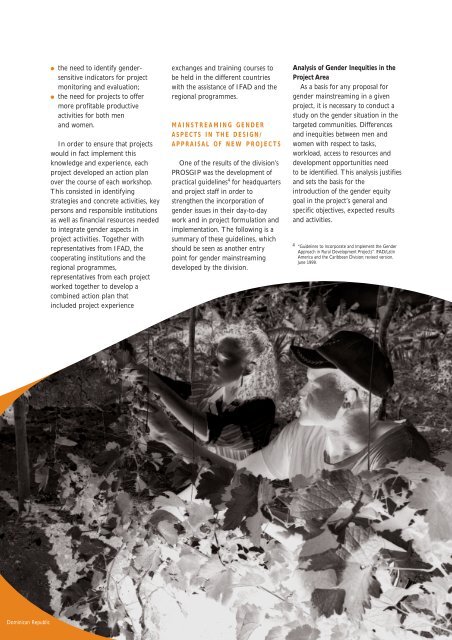III. Entry Points and Instruments for Gender Mainstreaming - IFAD
III. Entry Points and Instruments for Gender Mainstreaming - IFAD
III. Entry Points and Instruments for Gender Mainstreaming - IFAD
You also want an ePaper? Increase the reach of your titles
YUMPU automatically turns print PDFs into web optimized ePapers that Google loves.
●<br />
●<br />
the need to identify gendersensitive<br />
indicators <strong>for</strong> project<br />
monitoring <strong>and</strong> evaluation;<br />
the need <strong>for</strong> projects to offer<br />
more profitable productive<br />
activities <strong>for</strong> both men<br />
<strong>and</strong> women.<br />
In order to ensure that projects<br />
would in fact implement this<br />
knowledge <strong>and</strong> experience, each<br />
project developed an action plan<br />
over the course of each workshop.<br />
This consisted in identifying<br />
strategies <strong>and</strong> concrete activities, key<br />
persons <strong>and</strong> responsible institutions<br />
as well as financial resources needed<br />
to integrate gender aspects in<br />
project activities. Together with<br />
representatives from <strong>IFAD</strong>, the<br />
cooperating institutions <strong>and</strong> the<br />
regional programmes,<br />
representatives from each project<br />
worked together to develop a<br />
combined action plan that<br />
included project experience<br />
exchanges <strong>and</strong> training courses to<br />
be held in the different countries<br />
with the assistance of <strong>IFAD</strong> <strong>and</strong> the<br />
regional programmes.<br />
MAINSTREAMING GENDER<br />
ASPECTS IN THE DESIGN/<br />
APPRAISAL OF NEW PROJECTS<br />
One of the results of the division’s<br />
PROSGIP was the development of<br />
practical guidelines 4 <strong>for</strong> headquarters<br />
<strong>and</strong> project staff in order to<br />
strengthen the incorporation of<br />
gender issues in their day-to-day<br />
work <strong>and</strong> in project <strong>for</strong>mulation <strong>and</strong><br />
implementation. The following is a<br />
summary of these guidelines, which<br />
should be seen as another entry<br />
point <strong>for</strong> gender mainstreaming<br />
developed by the division.<br />
Analysis of <strong>Gender</strong> Inequities in the<br />
Project Area<br />
As a basis <strong>for</strong> any proposal <strong>for</strong><br />
gender mainstreaming in a given<br />
project, it is necessary to conduct a<br />
study on the gender situation in the<br />
targeted communities. Differences<br />
<strong>and</strong> inequities between men <strong>and</strong><br />
women with respect to tasks,<br />
workload, access to resources <strong>and</strong><br />
development opportunities need<br />
to be identified. This analysis justifies<br />
<strong>and</strong> sets the basis <strong>for</strong> the<br />
introduction of the gender equity<br />
goal in the project’s general <strong>and</strong><br />
specific objectives, expected results<br />
<strong>and</strong> activities.<br />
4 “Guidelines to Incorporate <strong>and</strong> Implement the <strong>Gender</strong><br />
Approach in Rural Development Projects”. <strong>IFAD</strong>/Latin<br />
America <strong>and</strong> the Caribbean Division; revised version,<br />
June 1999.<br />
Dominican Republic

















